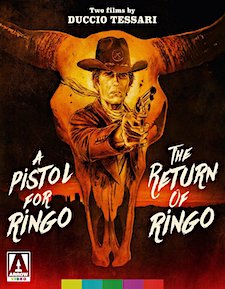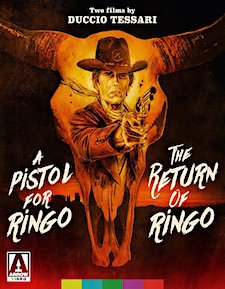Pistol for Ringo, A/The Return of Ringo (Blu-ray Review)

Director
Duccio TessariRelease Date(s)
1965 (April 24, 2018)Studio(s)
Cineriz/Embassy Pictures (Arrow Video)- Film/Program Grade: See Below
- Video Grade: See Below
- Audio Grade: See Below
- Extras Grade: C+
- Overall Grade: B-
Review
Westerns, or spaghetti westerns if you’re so inclined, were one of the many great filmmaking exports to come out of Italy during the 1960s and 1970s, even making Clint Eastwood a household name. They weren’t quite American, despite their American settings, but they weren’t totally Italian either, creating this interesting hybrid that ultimately became what we now associate with the western genre as a whole. Within this timeframe, a series of films about a lone gunslinger coming into town and cleaning up some of its less than savory inhabitants became popular in its homeland, but also did good business in the U.S. Not originally intended to be a series, the first two films, A Pistol for Ringo and The Return of Ringo, were successful enough that there was no stopping it, much like the Django and The Man With No Name films.
In A Pistol for Ringo, the titular character is brought in by the local sheriff to aid him in stopping a gang of outlaws after a successful bank robbery, holing themselves up at a plantation outside of town. We realize early on that Ringo is a great shooter after a group of men in the town try and take him on, getting gunned down in the process. But like the title implies, he lacks a sidearm for the majority of the film, relying on his wits in order to get himself out of sticky situations. He ultimately plays both the bad guys and the good guys for fools for unknown reasons, which doesn’t really pay off until the final minutes.
A Pistol for Ringo is also more playful than most westerns. It isn’t really a spoof or overtly comedic, but it contains enough lighthearted elements to take the edge off. At one point, Ringo utters the line “I’d give my kingdom for a gun... did somebody say that before me?”, to which a wounded man nearby mutters “Shakespeare.” A few jovial musical notes are played anytime Ringo is either up to something or gets the best of someone. The film even opens with two men approaching each other in a thoroughfare, and we fully expect them to draw their weapons and fire at each other. Instead, they simply shake hands and wish each other a Merry Christmas. To say the least, this isn’t your typical Italian western.
The Return of Ringo is a decidedly different affair and much more traditional by comparison. We are treated to most of the same cast members, but playing different characters, including Ringo himself. This time around, Ringo is portrayed as a man in disguise who is returning from war to his hometown, which has been taken over by a den of thieves and murderers and is headed up by a handsome but malevolent aristocrat who wishes to marry Ringo’s beloved wife.
More akin to A Fistful of Dollars (or even High Plains Drifter for that matter), The Return of Ringo is certainly a darker and more straightforward experience. Ringo is a tortured and calculating character, looking to exact his revenge when the time is right. I would almost recommend watching the two films with a lapse of time in between them, mainly due to the cast. Watching them back to back, the dynamics between the characters and the tone of the film can be somewhat disconcerting, almost taking one out of the film because of it. On its own, it’s a classic western tale of redemption that’s well-executed and extremely well-photographed, but I personally prefer the exuberance of its predecessor for how engaging and fun it is.
Arrow Video presents each film with transfers sourced from new 2K restorations from their original 35mm 2-perforation Techniscope camera negatives in their original aspect ratio of 2.35:1. Both films look pretty amazing. They’re extremely organic-looking with well-rendered grain and high levels of fine detail, particularly in close-ups and on costumes. A mild softness is present, but everything appears as crisp and detail-oriented for films of this vintage. Each film also carries a different color palette, with the first looking a tad more natural, and the second appearing much warmer. Skin tones reflect this, of course, but all appears lush and precise. Black levels fare well, particularly during night scenes, but they don’t always appear solid. Contrast and brightness is never a problem, nor is there much in the way of leftover debris, outside of some mild speckling and occasional hairs in the film gate. Some shots appear to have emulsion issues, but they’re infrequent and don’t last all that long.
For the audio, both films carry English and Italian mono DTS-HD tracks with subtitles in English for the Italian tracks and English SDH for the English tracks. For the first film’s audio, the Italian track is the more natural sounding of the two, giving the score, in particular, more room to breathe. It also seems slightly louder by comparison. The English track is fine in and of itself, but sounds a bit less wide. The second film’s audio, specifically the Italian option, is a little quieter than the English track. The English track also features a very noticeable wobble that detracts a bit from the presentation. I also noticed a couple of mild thumps, a bit of hiss, and some treble fluctuations here and there. Sync was also a bit loose, but then again, the subtitles offer different experiences of their own, often never matching their aural counterparts. However, Ennio Morricone’s scores are well-represented on all of the tracks, despite the minor quality issues.
A PISTOL FOR RINGO (FILM/VIDEO/AUDIO): B-/A-/B
THE RETURN OF RINGO (FILM/VIDEO/AUDIO): C+/A-/C+
Supplements for this release include two great audio commentaries with C. Courtney Joyner and Henry Parke, obvious fans and film historians in their own right; Revisiting Ringo, a new 38-minute appreciation by Tony Rayns who goes over not just the films themselves, but Tessari’s career and the Italian film landscape; They Called Him Ringo, a 22-minute archival interview with actors Lorella De Luca and Giulano Gemma; A Greek Western Tragedy, a 27-minute archival featurette with camera operator Sergio D’Offizi and Lorella De Luca; the U.S. and German theatrical trailers for A Pistol for Ringo; the U.S. and Italian theatrical trailers for The Return of Ringo; an image gallery of promotional material from the Mike Siegal Archive featuring 98 images in all; and last but not least, a 44-page insert booklet with the essays “Duel Roles: The Ringo Stars” and “Showdowns on Main Street: The Esplugas City Story” by Howard Hughes, “The Myth and the Author, from Home to Kurosawa: An Interview with Duccio Tessari” by Lorenzo De Luca, and restoration details.
After seeing these two films for the first time, I can safely say that director Duccio Tessari was to westerns what Robert Altman was to war and noir films, bringing a freshness and a kind of satirization to them, but also making worthy entries into the genre in the process. A Pistol for Ringo and The Return of Ringo (as well as their many follow-ups) are overshadowed by the success of Sergio Leone’s films, but they’re definitely worth your time if you’re a spaghetti western fan of any sort. In that capacity, Arrow Video’s presentations of each film are an excellent resource.
- Tim Salmons

